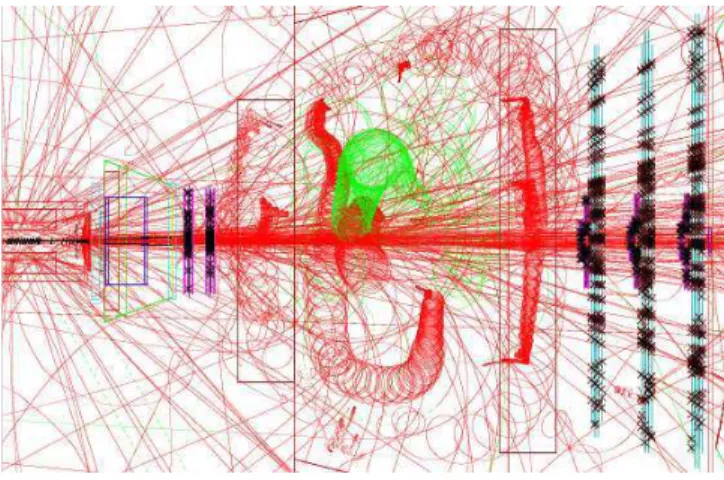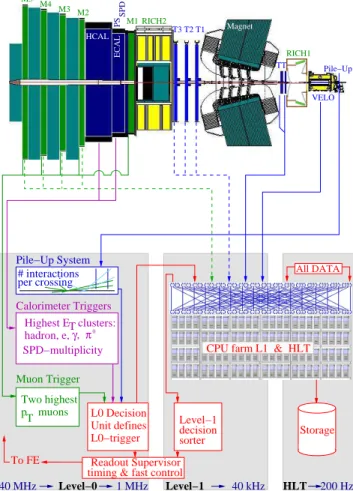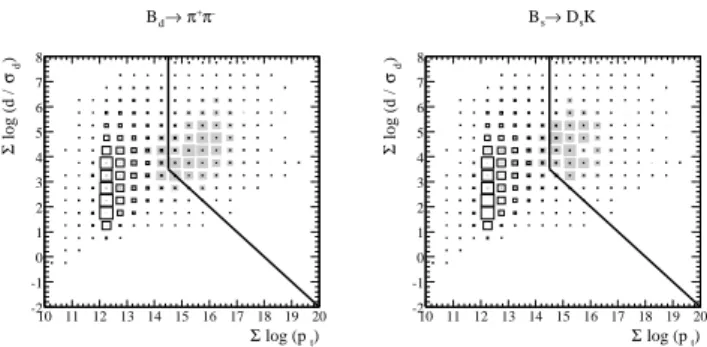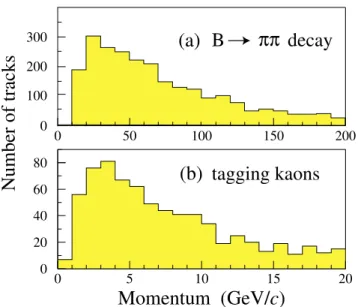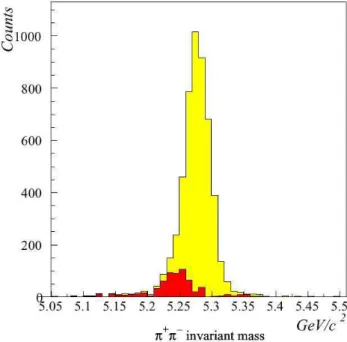CP Violation Prospects at the LHC
H. B. Dijkstra
CERN, CH-1211 Geneva 23, Switzerland
Received on 5 January, 2004
In the last few years experiments at B-factories have established CP violation inBddecays. From 2007 onward
new experiments will start to exploit the largeb¯bcross-section at the LHC to advance the understanding of CP violation by studying unprecedented large samples of all B-meson flavours. After a short review of the present status, the experimental challenges for the future experiments will be described. The emphasis will be on LHCb, a dedicated B-physics experiment at the LHC, and some examples of the projected physics results will be presented.
1
Introduction
In the Standard Model the charged current interactions of quarks is described by the Cabibbo-Kobayashi-Maskawa (CKM) matrix [1], i.e. the matrix gives the couplings of
W+-boson between the three families of up-down quark pairs:
V =
Vud Vus Vub Vcd Vcs Vcb Vtd Vts Vtb
.
Since it is unitary, the matrix can be parametrised with four independent parameters, including one phase, which intro-duces CP violation. One of the commonly used parame-terisations, introduced by Wolfenstein [2], is based on the parameters:λ,A,ρandη. In this parametrisation,V can be approximated as
V≈
1−λ2/2 λ Aλ3(ρ−i η)
−λ 1−λ2/2 Aλ2
Aλ3(1−ρ−i η) −Aλ2 1
,
whereλ= sin(θCabibbo) = 0.2240±0.0036[3], and only terms up toλ3are included.
The first observation of CP violation was in the neutral kaon system, and dates back to 1964. This phenomenon in combination with the work of Kobayashi and Maskawa led to the prediction of a third quark generation. The measu-rement of CP violation could lead eventually to the precise determination, and even over-constraint, of the CKM ma-trix elements if they can all consistently be described in the Standard Model framework. However, the hope is that new physics beyond the Standard Model will show up in a de-tailed comparison of the CP violating observables of many decays. The rational behind this expectation is that many extensions of the Standard Model introduce additional sour-ces of CP violation, which modify CP observables in a way that they can be distinguished from the Standard Model me-chanism [4]. It cannot be excluded that new physics at mass scales beyond the reach of direct searches will produce me-asurable effects in the CP violation sector. Another reason
for the expectation that new physics beyond the Standard Model might manifest itself via CP violation is that it is one of the three conditions for baryogenesis [5]. However, the CP violation generated through the CKM-phase appears to be far too small to generate the observed imbalance between matter and anti-matter in our universe.
Among the nine unitarity relation of the CKM matrix the following is one of the most relevant for B-hadron decays:
VudVub∗ +VcdVcb∗ +VtdVtb∗ = 0
A pictorial way to represent the above relation in the mo-dified Wolfenstein parameters[¯ρ,η¯]plane, which include a higher order correction inλ, is shown in Fig. 1. The angles denoted in the triangles are defined as:α= arg(−VtdVtb∗
VudVub∗ ),
β = arg(−VcdV∗cb VtdV∗tb)
andγ = arg(−VudV∗ub VcdV∗cb)
, and these an-gles can be accessed with CP violation measurements in B-decays.
2
CP Violation at the B-factories
The constraints on the CKM matrix [6] from all available measurements in the summer of 2003, but excluding the CP violation measurements in B-decays is shown in Fig. 2. The constraints come from|Vub/Vcb|, which is measured from tree diagram B-decays, from ǫK, the CP violation in the neutral kaon system, and from∆mdand the lower limit on
∆ms. It should be noted that∆mdis measured with high precision, but its interpretation in the CKM matrix is domi-nated by theoretical uncertainties. The result of the Standard Model fit [3] gives0.646 < sin(2β) < 0.789with a 95%
1 0 ρ(1−λ2/2)
η(1−λ2/2)
γ β
α
VudVub + VcdVcb + VtdVtb = 0
∗ ∗ ∗
Re Im
∗
(1−λ
2 /2)
Vub
λ |V
cb|
V
td
λ |V
cb|
= ρ
_
_ η
Figure 1. The unitarity relationVudVub∗ +VcdVcb∗ +VtdVtb∗ = 0
drawn in the complex[¯ρ,η¯]plane.
-1.5 -1 -0.5 0 0.5 1 1.5
-1 -0.5 0 0.5 1 1.5 2
∆md
∆ms&∆md
εK
εK
|Vub/Vcb|
α β γ
ρ
η
excluded area has < 0.05 CL
C K M
f i t t e r LP 2003
Figure 2. Confidence levels in the[¯ρ,η¯]plane as obtained by the CKMfitter group, excluding information from CP violation measu-rements in B-decays.
The first observation of CP violation outside the neu-tral kaon system was made only in 2001, when two new B-factories came on-line. The observation was made in tree diagramBd-decays viab → candW− → ¯c + s transiti-ons, such asBd → ψKS. These decays are dominated by a single tree diagram, and hence CP violation in decay can be neglected. Due to the GIM mechanism CP violation in mixing is predicted to be very small in the Standard Model, leaving only the interference of decays with and without mi-xing, facilitating the theoretical interpretation of the measu-red asymmetry in terms of CKM parameters. Fig. 3 shows the Standard Model tree diagram for theBd→ψKSdecay with and without mixing.
J/
ψ
K
Sw−
b
d
c
c
d
B
s
t
t
b
d
B
w−
Figure 3. Standard Model tree diagram for generatingBd→ψKS
decays.
Also experimentally nature has been kind to us, since the branching ration (BR) ofBd→ψ(→µ+µ−)K0S(→π+π−) is not too small, i.e. 20.10−6, and the B-meson decays into two narrow resonances, which allows an excellent back-ground rejection. Table I shows the integrated performance of the two B-factories KEKB and PEPII up till summer 2003. The two asymmetrice+e− accelerators operate most
of their time on theΥ(4s)resonance, which decays predo-minantly inB ¯B.
TABLE I. The performance of the two B-factories integrated till summer 2003.
KEKB PEPII E(e−) 8 GeV 9 GeV E(e+) 3.5 GeV 3 GeV
R
Ldt(2003) 158 fb−1 131 fb−1 R
Ldton peak 140 fb−1 113 fb−1
Detectors Belle Babar NrB ¯B-pairs 152×106 123×106
The producedB0B¯0-pairs evolve coherently, and hence have the opposite flavour at the time of the decay of one of the B-mesons. The two experiments, Belle [7] at KEKB and BaBar [8] at PEPII, are both detectors with a nearly4π cove-rage, equipped with a silicon vertex detector, a tracking de-tector, a Cherenkov detector and electromagnetic calorime-ter inside a 1.5 T superconducting solenoid, which in turn is surrounded by a tracking system for muon detection. Fig. 4 gives a cartoon of the type of events which are reconstructed by the experiments.
e+
e−
=∆ βγ
z
Ks
J/
ψ
Tag flavour
t
∆
Figure 4. Cartoon of the way aB0B¯0-pair evolves and decays at the B-factories.
The proper time difference between the two B-mesons is measured with the vertex detectors, while particle iden-tification is used to measure the flavour of the tagging B-meson. The asymmetry NB¯−NB
pro-Figure 5. Beam constrained mass of the variousb→ctransitions used by Belle to extract the asymmetry.
Figure 6. The raw asymmetry in variousb→ctransitions as me-asured by BaBar.
duction, is measured as a function of ∆t, and fitted with the expression Adircos(∆m∆t) + Amixsin(∆m∆t). The Standard Model expectations are Adir = 0, and
Amix = sin(2β). Fig. 5 shows the beam constrained mass
(p(ECM/2)2−(˜pJ/ψ+ ˜pKS)2) of the variousb→c tran-sitions used by Belle to extract the asymmetry. Fig. 6 shows
the raw asymmetry as measured by Babar [10], and the re-sult of the unbinned likelihood fit to extract the asymmetry parameters.
-1.5 -1 -0.5 0 0.5 1 1.5
-1 -0.5 0 0.5 1 1.5 2
sin2β(WA)
∆md
∆ms&∆md
εK
εK
|Vub/Vcb|
sin2β(WA)
α β γ
ρ
η
excluded area has < 0.05 CL
C K M
f i t t e r LP 2003
Figure 7. Confidence levels in the[¯ρ,η¯]plane as obtained by the CKMfitter group, including information from CP violation measu-rements in charmonium B-decays.
K
Sw−
w−
uct u c t
b
d
d
B
s
t
t
b
d
B
s
s
g
g
φ
Figure 8. Penguin diagram for generatingBd→φK0Sdecays.
Assuming that only Standard Model box diagrams con-tribute to theB−B¯ mixing, the collaborations have measu-red forsin(2β):
Belle:0.719±0.074(stat)±0.035(syst)
Babar:0.741±0.067(stat)±0.034(syst)
In excellent agreement with the prediction from a combined fit of the CKM elements presented above. Fig. 7 shows the constraints on the CKM matrix [6] from all available me-asurements in the summer of 2003, including the CP vio-lation measurements in the charmonium B-decays. Hence, the Kobayashi-Maskawa mechanism can explain CP viola-tion in flavour changing processes. In addiviola-tion, the first me-asurements of CP violation in the B-system imposes a signi-ficant constraint. However, this does not excluded new phy-sics contributions. The decayBd → φ(→ K+K−)K0S(→ π+π−), cannot proceed via a tree diagram, since it is a
Model penguin process is shown in Fig. 8, and since the pen-guin loop with the top quark dominates, CP violation in the decay can be neglected, and so for φKS the CP violation is expected to be dominated by the interference of decays with and without mixing. Hence in the Standard Model it is expected thatsin(2β)ψKS≈sin(2β)φKS. The two measure-ments are expected to agree withinO(λ∈)[11], or a few%.
But new (s)particles in the penguin loop could modify this, making the descrepancyO(λ)or evenO(∞). Experimen-tally these penguin decays are much more challenging, with the BR(Bd→φ(→K+K−)K0S(→π+π−)) = 1.4×10−6. Both Belle and Babar have reconstructed about 70 events consistent with the decayBd→φK0S. At the 2003 summer conferences they reported [12] based on a total of 250 fb−1 forsin(2β)φKS:
Belle:−0.96±0.50(stat)+0−0..0911(syst) Babar:+0.45±0.43(stat)±0.07(syst)
Fig. 9 summarizes the measurements ofsin(2β(eff))of both the charmonium and s-penguin decays of theBd. The results show a tendency ofsin(2βeff)of s-penguin decays to devi-ate from the determination ofsin(2β)from tree processes by more than what is expected within the Standard Model. However, the deviation is still not statistically significant. By 2006 it is expected that the data volume at the B-factories has increased from 250 fb−1now to 1000 fb−1.
-3 -2.5 -2 -1.5 -1 -0.5 0 0.5 1 1.5 2
sin(2β(eff))
Charmonium Modes
φ
K
0 S
η
, K 0 S
KKK
0 S
OPAL 98 ALEPH 00 CDF 00 BABAR 02
Belle 03
Average (charmonium)
BABAR 03
Belle 03
BABAR 03
Belle 03
Belle 03
Average (s penguin)
Average (All)
3.2 + 1.8– 2.0±0.5
0.84 + 0.82– 1.04±0.16
0.79 + 0.41– 0.44 0.741±0.067±0.034
0.733±0.057±0.028
0.736±0.049
0.45±0.43±0.07
–0.96±0.5 + 0.09– 0.11
0.02±0.34±0.03
0.43±0.27±0.05
0.51±0.26 + 0.19– 0.05
0.24±0.15
0.695±0.047
H F A GH F A G
Summer 2003
Figure 9. Summary of the measurements ofsin(2β(eff))as made
by [13].
Up till now CP violation in the B-system has only been firmly established in the b → c¯cs CP-eigenstates. Apart from looking for signs of new physics in comparing tree and penguin decays as presented above, other fruitful ways to check deviations from the Standard Model are to com-pare the other CKM-angles, and in particular the check: α+β +γ = π. As an example α can be accessed at B-factories by measuring a charmless CP-eigenstate like
Bd→π+π−. Table II shows the asymmetries measured by
Belle [14] and BaBar [15] inBd→π+π−decays. This par-ticular decay has both tree and penguin contributions, and interpreting measured asymmetries within the Standard Mo-del in terms of constraints on the CKM matrix parameters without having to rely on model dependent theoretical in-puts would require integrated luminosities at the B-factories of order 10 ab−1[16]. This is an order of magnitude larger than what is forseen to be accumulated before the start of the LHC in 2007.
TABLE II. The asymmetries measured for the decay
Bd→π+π−.
Babar Belle
R
L 113 fb−1 78 fb−1
Amix −0.40±0.22±0.03 −1.23±0.41+0.08
−0.07
Adir 0.19±0.19±0.05 0.77±0.27±0.08
3
b¯
b
-production at the LHC
The Large Hadron Collider (LHC) at CERN will collide pro-tons at a center of mass energy of 14 TeV. The processes which dominate the production ofb¯b-pairs can be subdivi-ded in three categories: flavour creation, flavour excitation and fragmentation. Flavour creation proceeds via two to two parton processes of the typeq+¯q→b+¯bandg+g→b+¯b, i.e. the annihilation of light quarks or the fusion of gluons. In flavour excitation a(¯b)-quark from the sea of one pro-ton scatters with a parpro-ton from the other propro-ton, making it very sensitive to the structure functions which describe the
b¯bcontent of the proton. The fragmentation category con-tains processes where the b-quarks do not participate in the initial hard parton scattering process, but whereb¯b-pairs are produced via f.i. gluon splitting. The relative contributions of the three categories have been studies at the Tevatron [17] by comparing inclusive b-quark cross-sections with Monte-Carlo models. Fig. 10 shows CDF and D0 data on the inte-grated inclusive b-quark total cross-section forpT > pminT inp¯pcollisions at√s= 1.8TeV. The data is compared with PYTHIA 6.158 [18] using the CTEQ4L structure functions. The Monte-Carlo model contributions are split in the three categories discussed above.
To model theb¯b-production at√s= 14TeV PYTHIA parameters have been tuned to data at lower energies, and the corresponding parameters have been extrapolated to the LHC energy. The LHCb collaboration [19] uses PYTHIA 6.2 with the CTEQ4L structure functions, and charged mul-tiplicty distributions from CDF and UA5 to make this extra-polation [20], and obtains that PYTHIA predicts a total ine-lastic cross section of 79.2 mb, and ab¯b production cross section of 633µb.
Figure 10. Total b-inclusive cross-section at√s= 1.8TeV as me-asured by CDF and D0 in the central rapidity region|y|<1, and compared to the expectation from PYTHIA 6.158 split out in the different processes discussed in the text.
to detect decay products of both b-quarks in the same event. Fig. 11 shows the expected correlation between the two b-quarks in pseudo-rapidity at 14 TeV, and overlaid the accep-tances of a central detector (ATLAS) and a forward spectro-meter (LHCb). The only data available on b-production is in the central region, while LHCb will operate at much large values of the pseudo-rapidity range. In addition, the corre-lation between the b-quarks depends on the production pro-cess, hence increasing the uncertainty in the expected num-ber of reconstructed and tagged B-events. For the estimated event yields at the LHC it is therefor conservatively assumed that the totalb¯bcross-section is 500µb, rather than the 633 µb predicted by PYTHIA.
-8
-6
-4
-2
0
2
4
6
8
-5
0
5
η
bη
b–
LHCb (15.1
%
)
ATLAS (34.7
%
)
Figure 11. The correlation between the pseudo-rapidities (η) of the two b-quarks as expected by PYTHIA in pp-interactions at 14 TeV. The acceptance of LHCb and ATLAS at the LHC are overlaid.
Apart from a copious production of B0 and B±, it is
expected that of all B-hadrons produced at the LHC, about 12% will be Bs, and about 10% will be beauty baryons. The design luminosity of the LHC machine is forseen to be1−2×1033 cm−2s−1 at the start-up, and after a se-veral years1034cm−2s−1. LHCb has chosen to run around
2×1032 cm−2s−1, to faciliate the triggering and recons-truction, and to make the radiation damage in the forward region more manageable. Even at this lower luminosity, the number ofb¯b-pairs produced at the LHC per unit time ex-ceed the production at a B-factory by four orders of mag-nitude. However, apart from these advantages, compared to the B-factories theσ(b¯b)/σ(inelastic)at the LHC is 30 times larger. This, combined with the large luminosity, cre-ates a challenging experimental environment. The detectors are subject to radiation damage, and the charged track mul-tiplicity per pp-interaction is typically about 30 within the acceptance of LHCb (1.8 < η <4.9) in events which con-tain ab¯b-pair. In addition the tagging at LHC is more di-luted compared to the B-factories, since the b-quarks do not evolve coherently, and the tagging B-meson might even be a rapidly ocillatingBs.
4
LHC B-physics Experiments
Over-view
Figure 12. The ATLAS detector, showing.
Compact Muon Solenoid
Pixel Detector Silicon Tracker Very-forward
Calorimeter
Electromagnetic Calorimeter Hadronic Calorimeter
Preshower
Muon Detectors Superconducting Solenoid
Figure 13. The CMS detector.
LHCb is a dedicated experiment for making precise stu-dies of CP asymmetries and rare decays in the b-hadron sys-tem, and its spectrometer is shown in Fig. 14.
It is a single arm spectrometer covering the range1.9< η < 4.9. It consists of a Silicon Vertex Locator (VELO) and four Silicon Trigger Tracker (TT) planes before a 4 Tm di-pole magnet. The tracking system behind the magnet consists of three multi-layer chambers (T1-T3), each cham-ber consisting of four Silicon planes close to the beam-line, surrounded by eight layers of 5 mm diameter straw tubes. Two Ring Imaging Cherenkov detectors (RICH1&2) pro-videπ/Kseparation over the momentum interval2< p < 100GeV/c. The calorimeter system consists of a Scintil-lating Pad Detector (SPD) to distinguish charged particles from photons, a Pre-Shower (PS), an Electromagnetic Calo-rimeter (ECAL) based on the Shashlik type, and a Hadro-nic Calorimeter (HCAL). Behind the calorimeter four Muon Chambers (M2-M5) provide muon reconstruction and iden-tification capability, while M1 is used to improve the mo-mentum resolution in the first trigger level. The low−β in-sertion at the LHCb interaction point allows LHCb to run at luminosities between2−5×1032cm−2s−1, even when the
LHC reaches its design luminosity of1034cm−2s−1. LHCb aims at running at these relatively low luminosities to avoid too much pile-up, note that at1034cm−2s−1there are about 20 pp-interaction per crossing, while at2×1032 cm−2s−1
80%of the crossings with interactions have only one visible interactions. Fig. 15 shows a typical B-event in LHCb. Note that most of the low momentum secondaries are trapped in the magnetic field inside the magnet, where no sensitive ele-ments are placed. On average LHCb reconstructs 26 tracks with hits in both the VELO and T1-T3.
250mrad 100mrad
M1
M3 M2
M4 M5
RICH2 HCAL ECAL SPD/PS Magnet
T1T2 T3
z 5m
y
5m
10m 15m 20m
TT Vertex
Locator RICH1
Figure 14. The LHCb detector, showing the VELO, TT and T1-3 tracking elements. The 4 Tm di-pole magnet, RICH1&2, the calo-rimeter system and the muon chambers.
Figure 15. The typical event in LHCb as produced by GEANT3.
What sets LHCb apart from the general purpose detec-tors ATLAS and CMS is especially the VELO, its trigger scheme, and the RICH detectors, and these will be presen-ted in some more detail in the next sections.
5
Vertex Detection
pixel detectors (see Fig. 16), arranged in three barrels with
44 < radius < 102 mm and end-caps. The size of the
45.106 pixels is150×150 µm2, which, using charge di-vision, provides a resolution of about 12µm inrφ. The ATLAS tracking system [24] consist of 65 m2 of Silicon strip sensors, read-out with6×106 channels. Like CMS, ATLAS has chosen to cope with the large track density and high radion damage close to the interaction point with a sys-tem of pixel detectors, as is shown in Fig. 17. It consist of three barrel layers between 5-13 cm radius, which contain
80×106pixels of50×300µm2, complemented with end-caps. The binary read-out provides about12µmresolution inrφ.
Figure 16. Schematic of the CMS pixel detector.
Figure 17. Schematic of the ATLAS pixel detector.
The forward geometry of LHCb is covered close to the interaction region with 0.23 m2 of Silicon strip detec-tors [25], read-out by 170k channels. There are two types of sensors, sensors with strips at constant radius (R-sensors), and sensors with quasi radial strips (Φ-sensors). An R-andΦ-sensor form one half-station, and the 42 half-stations are arranged perpendicular to the beam-line as is shown in Fig. 18. The strip pitch and length varies as a function of the radial position of the strips, with strips close to the beam-line having a pitch of40µmand being only 6 mm long. Using charge division a resolution down to7µmis obtained. The sensitive area of the sensors starts at only 8 mm from the beam-line, resulting in a radiation dose several times larger than what is expected in ATLAS and CMS, despite the much reduced luminosity. It is forseen to replace the sensors every few years. The aperture required by the LHC beam during injection requires the sensors to be retracted to a distance of 3 cm from the beam line, and hence the sensors are placed
in Roman-pots, and are separated from the LHC vacuum by a 250µm thick Al-foil.
Readout Chips
diodes routing lines
RF−foil
−sensors
Φ R−sensors
Figure 18. Schematic of the LHCb VELO.
Excellent proper time resolution is not only required to distinguish B-meson decays from a large combinatoric background, but is also essential to resolve the fast os-cillation ofBs mesons, which is expected to be ∆ms =
18.3±1.7 ps−1 [3]. The value of∆m
scan be measured inBs →D−sπ+decays, and the proper time resolution ex-pected for this decay in ATLAS, CMS and LHCb is 70 ps−1, 65 ps−1and 40 ps−1respectively. Fig. 19 shows the proper time distribution ofBs → D−sπ+ candidates as simulated and reconstructed by LHCb for two different assumptions of∆ms. Based on one year of data LHCb is expected to be able to make a five standard deviation observation ofBs oscillation up to∆ms = 68 ps−1 [19]. If∆ms turns out to be close to its the Standard Model expectation, LHCb should be able to measure it within a few weeks of running. The corresponding reach for the equivalent of one year of ATLAS [26], i.e. 10 fb−1, is 22.5 ps−1. The difference in reach is not only driven by the superior impact parameter resolution of LHCb, but also by the much larger statistics which can be accumulated by LHCb for this channel due to its trigger, which will be described in the next section.
Events
100 200 300
-1
= 15 ps
s
m
∆
t (ps)
0 1 2 3 4 5 6
Events
100 200 300
-1
= 25 ps
s
m
∆
Figure 19. Proper time distribution ofBs → D−s π+ candidates
6
Triggering on B-mesons
Table III gives an overview of the different strategies utilised by the three experiments to reduce the LHC 40 MHz clock frequency to the few hundred Hz of events which will be written to storage.
Both ATLAS [27] and CMS [28] use the first hardware based trigger level to reduce the rate to<100 kHz, by re-quiering a muon or two muons to be present with sufficient pT. The actualpTthresholds which will be applied for the B-physics trigger will depend on the available band-width for these triggers at the different luminosities. Thresholds which still give a competitive efficiency in the range 4-14 GeV/c for the single muon trigger can only be employed for low luminosities around1033cm−2s−1 during the start-up phase of the LHC, or maybe at the end of a fill. Based on the hardware trigger ATLAS defines Regions-of-Interest (RoI), and the data inside a RoI is transferred to a CPU for further selection. Full event building is then performed at a rate of 1 kHz, after which High Level Trigger (HLT) algorithms make the final selection to reduce the rate to 100 Hz. CMS per-forms full event building already at a rate of 100 kHz, which is reduced at start-up to 50 kHz. Their HLT first performs a pre-HLT, based on the information from the hardware trig-ger, to reduce the rate at which full track reconstruction can be performed for the final selection of the about 100 Hz of events written to storage.
TABLE III. Overview of trigger strategies of ATLAS, CMS and LHCb for triggering on B-mesons.
ATLAS CMS LHCb
Rate 40 MHz 40 MHz 40 MHz
Data µ, µµ µ, µµ µ, µµ,e, γ, π0,h
Type Hardware Hardware Hardware
Rate 1 MHz
Data VELO, TT,
first level objects
Type CPU-farm
Rate 70−100kHz <100kHz 40 kHz Data RoI Full event Full event Type CPU-farm CPU-farm CPU-farm Algorithm Seed based Seed based Seed based Rate 1 kHz variable <20kHz Data Full event Full event Full event Type CPU-farm CPU-farm CPU-farm
Storage 100 Hz 100 Hz 200 Hz
The LHCb [29] trigger is dedicated to select B-mesons, and hence aims at being able to trigger on relatively small pThadrons, leptons or photons with high efficiency. Fig. 20 shows a schematic of the LHCb trigger system. The LHCb trigger is subdivided in three trigger levels, called Level-0, Level-1 and HLT. The LHC beam crossing rate of 40 MHz contains about10MHz of crossings with visible pp-interactions at the LHCb luminosity, and the hardware trig-ger is used to reduce this rate to a rate at which in principle all sub-systems could be used for deriving a trigger decision.
Due to a combination of their large mass andpTb-hadrons decay to give a largeETlepton, hadron or photon. Level-0 reconstructs:
• the highestET hadron, electron and photon clusters in the Calorimeter,
• up to the two highestpTmuons in the Muon Cham-bers,
which information is collected by the Level-0 Decision Unit to select events. Events can be rejected based on global event variables such as charged track multiplicities and the number of interactions, as reconstructed by the Pile-Up system, to assure that the selection is based on b-signatures rather than large combinatorics, and that these events will not occupy a disproportional fraction of the data-flow bandwidth or available processing power in subsequent trigger levels.
PS
SPD
Level−1 decision sorter
Pile−Up
TT
M2 M1 M3
M4
ECAL
HCAL
Magnet M5
Storage
200 Hz
40 kHz HLT
1 MHz
per crossing # interactions
T3 T2 T1
To FE
40 MHz
All DATA
Readout Supervisor timing & fast control
Muon Trigger
SPD−multiplicity Calorimeter Triggers
Level−0 Level−1
Pile−Up System
RICH2
RICH1
CPU farm L1 & HLT
L0 Decision Unit defines L0−trigger hadron, e,
Highest E clusters:
γ, π0
Two highest p muons
T
T
VELO
Figure 20. Schematic of the LHCb Trigger System.
are counted to provide a measure of the charged track mul-tiplicity in the crossing.
The muon chambers allow stand-alone muon reconstruc-tion with apTresolution of20%. Track finding is performed in the five muon stations by combining the strips and pads to form towers pointing towards the interaction region, and the two muons with the largest pT in the crossing are recons-tructed.
The Pile-Up system aims at distinguishing between cros-sings with single and multiple visible interactions. It uses four R-sensors of the same type as those used in the VELO to measure the radial position of tracks, covering−4.2 < η <−2.9. The Pile-Up system provides the position of the primary vertex candidates along the beam-line and a mea-sure of the total backward charged track multiplicity.
The Level-0 Decision Unit (L0DU) collects all informa-tion from Level-0, and with simple arithmetic combines all signatures into one decision per crossing.
At the 1 MHz output rate of Level-0 the remaining ana-logue data is digitized and all data is stored for the time needed to process the Level-1 algorithm. The Level-1 al-gorithm will be implemented on a commodity processors farm, which is shared between Level-1, HLT and offline re-construction algorithms. The Level-1 algorithm uses the in-formation from Level-0, the VELO and TT. The algorithm reconstructs tracks in the VELO, and matches these tracks to Level-0 muons or Calorimeter clusters to identify them and measure their momenta. The fringe field of the magnet between the VELO and TT is used to determine the mo-menta of particles with a resolution of 20–40%. Events are selected based on tracks with a largepTand significant im-pact parameter to the primary vertex. Fig. 21 shows the sum of log(pT) of the tracks with the largestpT in the event, and the sum of log(d/σd), their impact parameter
signifi-cance, as determined by the Level-1 algorithm. The maxi-mum Level-1 output rate has been fixed to 40 kHz, at which rate full event building is performed. The implementation is easily scalable to allow the inclusion of stations T1–T3 and M2–M5, which will improve the Level-1 performance.
-π + π → d
B Bs→ DsK
) t log (p
Σ
10 11 12 13 14 15 16 17 18 19 20
) d
σ
log (d /
Σ -2 -1 0 1 2 3 4 5 6 7 8 ) t log (p Σ
10 11 12 13 14 15 16 17 18 19 20
) d
σ
log (d /
Σ -2 -1 0 1 2 3 4 5 6 7 8
Figure 21. Distributon of off-line selected signal events (closed squares) and minimum bias events (open squares) in the plane of the two discriminating variables used by the LHCb Level-1 trigger.
The HLT will have access to all data. Level-1 and HLT event building share the same network. The HLT and Level-1 algorithms run concurrently on the same CPU nodes, with the Level-1 taking priority due to its limited latency budget of 58 ms. The HLT algorithm starts with a pre-trigger, which
aims at confirming the Level-1 decision with better resolu-tion, followed by selection algorithms dedicated to either select specific final states, or generic cuts to enrich the B-content of the events written to storage. The total CPU farm will contain about 1800 nodes, and the L1 and HLT algo-rithms will use about55%and25% of the available com-puting resources respectively. The remaining resources are used to fully reconstruct events accepted by the HLT, in-cluding the particle identification, before being written to storage. Fig. 22 shows the efficiency achieved by LHCb for some representative channels by the Level-0 and Level-1 triggers, measured for events which pass the off-line selec-tion cuts, which have been tuned to achieve sufficient back-ground rejection. It is expected that the HLT trigger will reach nearly 100% efficiency. Fig. 23 shows the expected annual un-tagged event rates after trigger and off-line selec-tion cuts.
The expected yield for 10 fb−1by ATLAS and CMS for
Bs → ψ(→ µ+µ−)φ(→ K+K−), a channel which is fa-voured by the first level trigger, is 100k and 84k events res-pectively. The corresponding annual event yield of LHCb is 100k events. For channels which do not contain muons the LHCb trigger provides a large advantage, since it can also trigger on hadronic final states. ATLAS and CMS can only trigger these events in their first trigger levels via a semi-leptonic decay of the tagging B-meson in a muon. ATLAS and CMS expect forBs → D−s(→ K+K−π−)π+ a yield of 3.3k and 0.15-5.5k events respectively. The large range of the yield of CMS reflects the range in threshold settings of the first level trigger, which will depend on the allowed bandwidth for B-physics. The corresponding annual yield in LHCb is 80k events, however the ATLAS and CMS events will nearly all be tagged because of the first level trigger se-lection on the muon. The correspondin tagged LHCb yield will be 44k events, still an order of magnitude larger.
At one of the B-factories the yield in Bd → ψ(→ µ+µ−)K0
Sso far is about 2k events. The corresponding an-nual yield expected in LHCb will be 220k events. Similarly the expected rate forBs → π+π− at a B-factory so far is 200 events, while LHCb expects 26k events per year. Hence due to trigger and acceptance losses the four orders larger
b¯bproduction in LHCb has been reduced to about two or-ders of magnitude of useful events. For final states which require tagging, the B-factories have the advantage that the B-mesons evolve coherently, and that there is no spectator background in the event. As a consequence the effective tagging efficiencyǫef f =ǫtag(1−2w)2, whereǫtagis the
efficiency to tag an event andwis the mis-tag probability, at the B-factories is 28%, while in LHCbǫef f is around5%.
7
Hadron Identification
L0-eff
L1-Eff
L0xL1-Eff
Figure 22. Efficiency of the first two trigger levels in LHCb for events which are accepted by the off-line reconstruction. For each channels the Level-0, Level-1 and combined efficiency is given.
at 14 TeV, the momentum of the tagging kaons which tra-verse the spectrometer starts around 1 GeV. LHCb is equip-ped with two RICH detectors [30, 19] to provideπ/K/p
identification over a momentum range of 2 to 100 GeV/c. RICH1 is located before the magnet, and uses Aerogel and
C4F10as radiatiors, which provide positive kaon identifica-tion above 2.0 GeV/c and 9.3 GeV/c respectively. RICH2 is sandwiched between the T3 tracker and the calorimeter, and itsCF4gas threshold for kaons is 15.6 GeV/c. The photons are reflected and focused outside the LHCb acceptance by spherical mirrors, and the total area to cover with segmen-ted photon detectors is 2.6 m2. The typical segmentation required at the focal plane is 2.5×2.5 mm2, and will be equipped with Pixel Hybrid Photon Detectors [31].
Figure 23. Annual event yields expected by LHCb for some repre-sentative channels.
0 200
100
300
(a)
0 20 40 60 80
0 5 10 15 20
(b)
Momentum (GeV/
c
)
Number of tracks
tagging kaons
B decay
ππ
0 50 100 150 200
Figure 24. Momentum distribution of a) the pion with the highest momentum fromBd→π+π−and b) tagging kaons in the LHCb
-60 -40 -20 0 20 40 60
-60 -40 -20 0 20 40 60
x
(cm)
y
(cm)
RICH 1
Figure 25. Event display of the RICH1 performance, showing the detected photons, the rings reconstructed for tracks which traverse the whole spectrometer (full lines), and the rings of local tracks (dasked lines).
Particle identification is performed by constructing a global likelihood including all tracks which have been re-constructed and the observed photon rings in the two RICH detectors. Fig. 25 shows an event display of a typical event, with the result of the reconstruction overlayed. The hadron identification performance of the two RICH detectors is il-lustrated in Fig. 26, which shows the invariant mass dis-tribution of two oppositely charged pions with the RICH information taken into account. Neither ATLAS not CMS are equipped with dedicatedπ/Kseparation detectors, and hence the signal from all the two-body decays of b-hadrons cannot be distinguished on an event by event basis. Fig. 27 shows the invariant π+π− mass distribution of ATLAS,
where the signal is dwarfed by background, coming mainly from Bd → K+π−, Bs → π+K−, Bs → K+K−, and
Λb→pπ−or pK−.
8
Expected Asymmetry Sensitivities
The B-factories achieved a sensitivity of around 0.07 in
sin(2β). All three LHC experiments expect to be able to
get a precision of around 0.02 in this asymmetry after one year of running. Babar and Belle have measured Amix
π+π−
andAdir
π+π− with precisions between 0.2 and 0.4 based on
all their accumulated data so far. LHCb is expected to me-asure these asymmetries with a precision around 0.06 based on one year data taking. But more importantly, at the LHC one can access also theBsdecays. Combining the asymme-tries measured in Bd → π+π− with its U-spin symmetric equivalentBs → K+K−, and assuming U-spin symmetry, allows LHCb to extract the angleγwith a precison of4−6◦,
again based on the yield of one year. Time-dependent decay asymmetries inBs→ D∓sK±will yieldσ(γ) = 14−15◦,
without theoretical assumptions. Another promising chan-nel to determineγwithout theoretical uncertainty is to study the time-integrated rates ofBd → D0K⋆0,Bd → D¯0K⋆0 andBd →D0CPK⋆0. Despite the small yield, i.e. only 600
Bd → D0CPK⋆0,σ(γ) = 7−8◦is the expected precision, since these modes are flavour specific, and therefor do not require tagging. It must be noted that each of these three ways of measuringγwill be differently affected by physics beyond the Standard Model. The experiments have been de-signed to collect data for many years, hence allowing the angles of the CKM triangle to be determined with a preci-sion of a few degrees.
Figure 26. Invariant mass ofπ+π−making use of the RICH in-formation in LHCb. The remaining background is indicated with a dark shading.
9
Conclusion
The first generation of CP violation experiments in the B-system, Belle and Babar at the B-factories, constrain the CKM matrix already considerably. The search for new phy-sics beyond the Standard Model requires much larger statis-tics, combined with the study of other B-meson decays than those accessible at the B-factories, like Bs-decays. Three experiments are under construction to exploit the copious production of all B-flavours at the LHC: ATLAS, CMS and LHCb. While ATLAS and CMS have been designed to per-form direct searches for Higgs and supersymmetry, LHCb is a dedicated experiment aimed at studying CP violation in the B-system. ATLAS and CMS are expected to contribute by measuring asymmetries mainly in channes with leptons in the final state for the first few years of LHC operation at luminosities an order of magnitude lower than the design luminosity. LHCb combines:
• a dedicated trigger system, • excellent proper time resolution, • good tracking,
• ability to identify charged and neutral hadrons, mu-ons, electrons and photmu-ons,
• acceptable background rejection and • adequate flavour tagging performance in pursued of identifying new physics.
Acknowledgements
I would like to thank Dr. N. Tuning for providing the figures and numbers of the PYTHIA simulation, and Prof. T. Na-kada for carefully reading the manuscript and many helpfull suggestions.
References
[1] M. Kobayashi and T . Maskawa, Prog. Theor. Phys. 49 (1973) 652.
N. Cabibbo, Phys. Rev. Lett. 10 (1963) 531.e
[2] L. Wolfenstein, Phys. Rev. Lett. 51 (1983) 1945.
[3] “The CKM matrix and the unitarity triangle”, Workshop held at CERN, 13-16 February 2002, editors: M. Battaglia, A.J. Buras, P. Gambino and A. Stocchi. CERN-2003-002-corr, 10 October 2003.
[4] M. Gronau and D. London, Phys. Rev. D55, 2845 (1997) Y. Nir, hep-ph/0208080 v3 (2003)
[5] A. Sakharov, JTEP Lett. 5, 24 (1967)
[6] From: http://ckmfitter.in2p3.fr
” A New Approach to a Global Fit of the CKM Matrix”, H. H¨ocker, H. Lacker, S. Laplace and F. Le Diberder, Eur. Phys. J. C21, 225-259 (2001)
[7] Belle Collaboration, A. Abashian et al., Nucl. Instr. Meth.
A479, 117 (2002).
[8] Babar collaboration, B. Aubert et al., Nucl. Instr. Meth.
A479, 1 (2002)
[9] K. Abe, et al.(Belle Collaboration), Phys. Rev. D66, (2002) 071102
[10] B. Aubert, et al.(BaBar Collaboration), Phys. Rev. Lett. 89, (2002) 201802
[11] R. Fleischer and T. Mannel, hep-ph/0103121.
[12] “Results on the CKM Angle φ1(β)”, T.E. Browder,
http://conferences.fnal.gov/lp2003/program/index.html.
[13] http://www.slac.stanford.edu/xorg/hfag/index.html
[14] K .Abe et al., Phys. Rev. D67, 03110(R) (2003)
[15] B.Aubert et
al., Phys. Rev. Lett. 89, 281802 (2002), and updated numbers in “CKM Unitarity Anglesα(φ2)andγ(φ3)”, A. Jawahery,
http://conferences.fnal.gov/lp2003/program/index.html.
[16] “Interpreting CP Asymmetries in B0 → π+π− decays”, A. H¨ocker et al., LAL 2002-103.
[17] R.D. Field, Phys. Rev. D65, 094006 (2002)
[18] T. Sj¨ostrand and M. van Zijl, Phys. Rev. D36, 2019 (1987) [19] “LHCb Reoptimized Detector Design and Performance
Te-chnical Design Report”, LHCb, CERN LHCC 2003-030.
[20] P. Bartelini et al., LHCb/1999-028, contributon to the 1999 Workshop on Standard Model Physics (and more) at the LHC, CERN 2000-4, May 200.
[21] ATLAS Detector and Physics Performance Technical Design Report, CERN/LHCC/99-14 and 99-15 (1999)
[22] CMS Technical Proposal, CERN/LHCC 94-38, 1994.
[23] L. Silvestris, Nucl. Phys. B120, 239 (2003)
[24] E. Rose, Nucl. Phys. B120, 235 (2003)
[25] U. Parzefall, Nucl. Phys. B120, 230 (2003)
[26] S. Gadomski, Nucl. Phys. B120, 299 (2003)
[27] J. Baines, Nucl. Phys. B120, 139 (2003)
[28] CMS: The Trigger/DAQ Project, Technical Design Report, Vol II, CERN/LHCC 02-26 (2002).
[29] LHCb Trigger System Technical Design Report, CERN/LHCC 2003-31 (2003).
[30] LHCb RICH Technical Design Report, CERN/LHCC 2000-37 (2000).
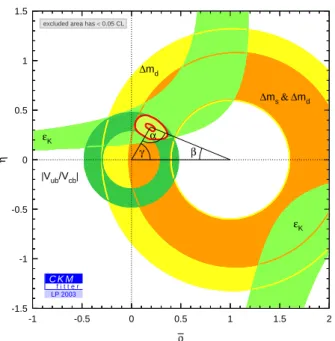
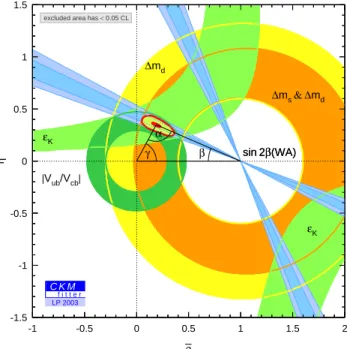
![Figure 9. Summary of the measurements of sin(2β (eff) ) as made by [13].](https://thumb-eu.123doks.com/thumbv2/123dok_br/18980198.456751/4.892.114.459.555.900/figure-summary-measurements-sin-β-eff.webp)

